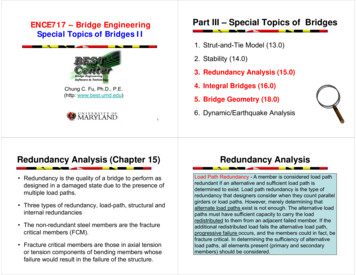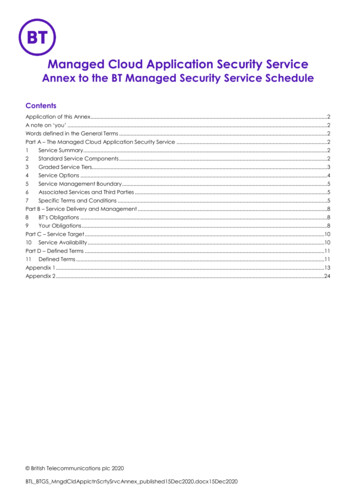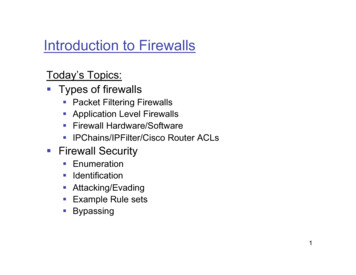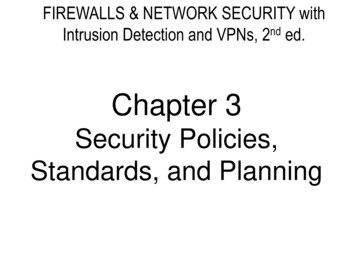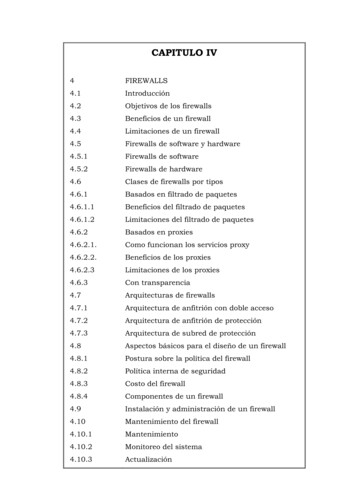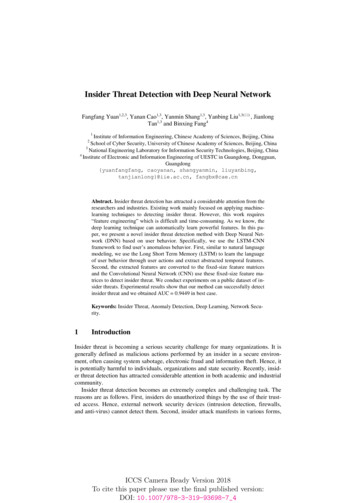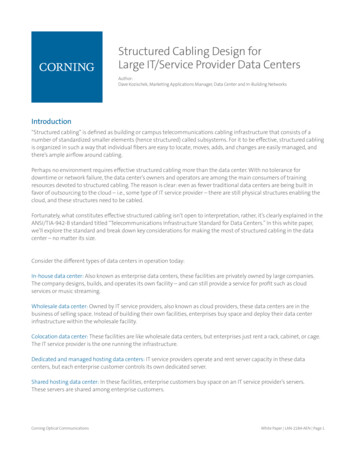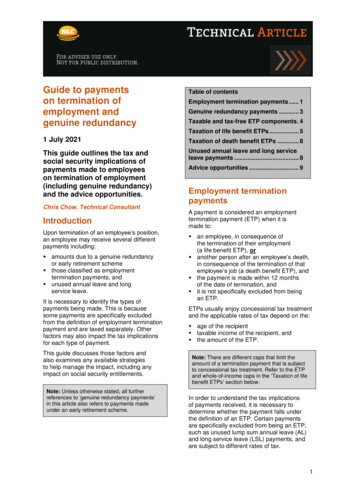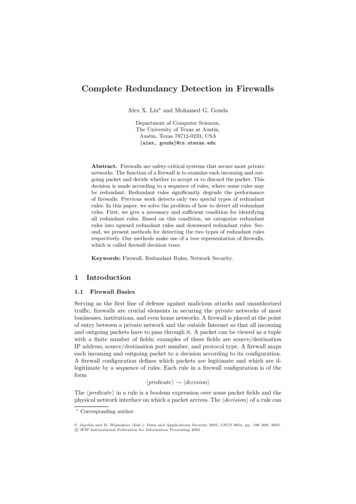
Transcription
Complete Redundancy Detection in FirewallsAlex X. Liu and Mohamed G. GoudaDepartment of Computer Sciences,The University of Texas at Austin,Austin, Texas 78712-0233, USA{alex, gouda}@cs.utexas.eduAbstract. Firewalls are safety-critical systems that secure most privatenetworks. The function of a firewall is to examine each incoming and outgoing packet and decide whether to accept or to discard the packet. Thisdecision is made according to a sequence of rules, where some rules maybe redundant. Redundant rules significantly degrade the performanceof firewalls. Previous work detects only two special types of redundantrules. In this paper, we solve the problem of how to detect all redundantrules. First, we give a necessary and sufficient condition for identifyingall redundant rules. Based on this condition, we categorize redundantrules into upward redundant rules and downward redundant rules. Second, we present methods for detecting the two types of redundant rulesrespectively. Our methods make use of a tree representation of firewalls,which is called firewall decision trees.Keywords: Firewall, Redundant Rules, Network Security.1Introduction1.1Firewall BasicsServing as the first line of defense against malicious attacks and unauthorizedtraffic, firewalls are crucial elements in securing the private networks of mostbusinesses, institutions, and even home networks. A firewall is placed at the pointof entry between a private network and the outside Internet so that all incomingand outgoing packets have to pass through it. A packet can be viewed as a tuplewith a finite number of fields; examples of these fields are source/destinationIP address, source/destination port number, and protocol type. A firewall mapseach incoming and outgoing packet to a decision according to its configuration.A firewall configuration defines which packets are legitimate and which are illegitimate by a sequence of rules. Each rule in a firewall configuration is of theform predicate decision The predicate in a rule is a boolean expression over some packet fields and thephysical network interface on which a packet arrives. The decision of a rule can Corresponding author.S. Jajodia and D. Wijesekera (Eds.): Data and Applications Security 2005, LNCS 3654, pp. 196–209, 2005.c IFIP International Federation for Information Processing 2005
Complete Redundancy Detection in Firewalls197be accept, or discard, or a combination of one of these decisions with other optionssuch as a logging option. For simplicity, we assume that the decision in a ruleis either accept or discard. Since the focus of this paper is firewall configuration,later we use “firewall” to mean “firewall configuration” if not otherwise specified.A packet matches a rule if and only if (iff ) the packet satisfies the predicateof the rule. The predicate of the last rule in a firewall is usually a tautology toensure that every packet has at least one matching rule in the firewall. Firewallrules often conflict. Two rules in a firewall conflict iff they not only overlap butalso have different decisions. Two rules overlap iff there is at least one packet thatcan match both rules. Due to conflicts among rules, a packet may match morethan one rule in a firewall, and the rules that a packet matches may have differentdecisions. To resolve conflicts among rules, for each incoming or outgoing packet,a firewall maps it to the decision of the first (i.e., highest priority) rule that thepacket matches.1.2Redundant RulesFirewalls often have redundant rules. A rule in a firewall is redundant iff removingthe rule does not change the function of the firewall, i.e., does not change thedecision of the firewall for every packet. For example, consider the firewall inFigure 1, whose geometric representation is in Figure 2. This firewall consists offour rules r1 through r4 . The domain of field F1 is [1, 100].We have the following two observations concerning the redundant rules inthe firewall in Figure 1.1. Rule r3 is redundant. This is because the first matching rule for all packetswhere F1 [30, 50] is r1 , and the first matching rule for all packets whereF1 [51, 60] is r2 . Therefore, there are no packets whose first matchingr1r2r3r4::::F1F1F1F1 [1, [40, [30, [51,50] accept90] discard60] accept100] discardFig. 1. A simple firewallr1 :1acceptr4 :discard40r2 :r3 :5030accept519060discard100Fig. 2. Geometric representation of the firewall in Figure 1
198A.X. Liu and M.G. Goudarule is r3 . We call r3 an upward redundant rule. A rule r in a firewall isupward redundant iff there are no packets whose first matching rule is r.Geometrically, a rule is upward redundant in a firewall iff the rule is overlayedby some rules listed above it.2. Rule r2 becomes redundant after r3 is removed. Note that r2 is the firstmatching rule for all packets where F1 [51, 90]. However, if we remove r2(assuming that r3 has been removed), the first matching rule for all thosepackets becomes r4 instead of r2 . This does not change the function of thefirewall since both r2 and r4 have the same decision. We call r2 a downwardredundant rule. A rule r in a firewall is downward redundant iff for eachpacket, whose first matching rule is r, the first matching rule below r hasthe same decision as r.Redundant rules significantly degrade the performance of firewalls. A firewall maps a packet to the decision of the first rule that the packet matchesusing packet classification algorithms. A packet classification algorithm mapseach packet to the right decision using an internal data structure built from afirewall of a sequence of rules. The fewer the rules in a firewall are, the faster apacket classification algorithm can map a packet to the right decision. To map agiven packet to the decision of the first rule that the packet matches, according tothe complexity bounds from computational geometry [15], the “best” softwarebased packet classification algorithm uses either O(nd ) space and O(log n) timeor O(n) space and O(logd 1 n) time, where n is the total number of rules and d(d 3) is the total number of fields that the firewall examines for every packet.Clearly, for software-based packet classification algorithms, either space or running time grows quickly as the number of rules increases. Reducing the spacethat a software-based packet classification algorithm needs also helps to reducethe running time of the algorithm because small space consumption could enablethe use of very limited on-chip cache to store the data structure of the algorithm.All in all, for software-based packet classification algorithms, it is advantageousto reduce the number of rules in a firewall. For hardware-based packet classification algorithms, it is also advantageous to reduce the number of rules in afirewall. Consider the example of a TCAM (Ternary Content Addressable Memory). A TCAM uses O(n) space and constant time in mapping a given packetto the decision of the first rule the packet matches. Moreover, TCAM consumesless power as the number of rules decreases.1.3Related WorkPrevious work on firewalls has primarily focused on firewall design (see [5, 6, 10,13, 8]) and firewall analysis (see [14, 16, 11, 12, 7]). None of these papers addressthe issue of redundant rules. The problem of detecting redundant rules onlyreceives attention in [9, 2, 3, 4].In [9], two special types of redundant rules are identified: backward redundantrules and forward redundant rules. A rule r in a firewall is backward redundantiff there exists another rule r listed above r such that all packets that match r
Complete Redundancy Detection in Firewalls199also match r . Clearly, a backward redundant rule is an upward redundant rule,but not vice versa. For example, rule r3 in Figure 1 is upward redundant, but notbackward redundant. A rule r in a firewall is forward redundant iff there existsanother rule r listed below r such that the following three conditions hold: (1)all packets that match r also match r , (2) r and r have the same decision, (3)for each rule r listed between r and r , either r and r have the same decision,or no packet matches both r and r . Clearly, a forward redundant rule is adownward redundant rule, but not vice versa. For example, rule r2 in Figure1, assuming r3 has been removed previously, is downward redundant, but notforward redundant. It has been observed in [9] that 15% of the rules in real-lifefirewalls are backward redundant or forward redundant.The redundant rules identified in [2,3,4] are similar to those identified in [9],except that for the case of backward redundant rules, they require that the tworules r and r must have the same decision.The bottom line is that the set of redundant rules identified by previous workis incomplete. In other words, given a firewall, after we remove the redundantrules identified in previous work, the firewall still possibly has redundant rules.So, how to detect all the redundant rules in a firewall? This is a hard problemand this problem has never been addressed previously.1.4Our ContributionIn this paper, we solve the problem of detecting all redundant rules in a firewall.First, we give a necessary and sufficient condition for identifying all redundantrules. Based on this condition, we categorize redundant rules into upward redundant rules and downward redundant rules. Second, we present methods fordetecting the two types of redundant rules respectively. Our methods make useof a tree representation of firewalls, which is called firewall decision trees.Note that removing redundant rules can be done by firewall software internally. Therefore, the external firewall configuration, i.e., the original sequenceof rules which is viewed by firewall administrators, would remain the same. Inother words, the procedure of removing redundant rules can be transparent tofirewall administrators. Also note that applying our procedure of removing redundant rules does not prevent a firewall administrator from updating a firewallconfiguration. When the configuration of a firewall is changed due to some rulesbeing inserted, deleted or modified, firewall software always needs to rebuild itsinternal data structure from the new sequence of rules.2Firewall Redundant RulesWe define a packet over the fields F1 , · · · , Fd as a d-tuple (p1 , · · · , pd ) where eachpi is a value in the domain D(Fi ) of field Fi , and each D(Fi ) is an intervalof nonnegative integers. For example, the domain of the source address in anIP packet is [0, 232 1]. We use Σ to denote the set of all packets over fieldsF1 , · · · , Fd . It follows that Σ is a finite set and Σ D(F1 ) · · · D(Fn ) .
200A.X. Liu and M.G. GoudaA firewall over the fields F1 , · · · , Fd is a sequence of rules, and each rule is ofthe following format:(F1 S1 ) · · · (Fd Sd ) decision where each Si is a nonempty subset of D(Fi ) and decision is either accept ordiscard . For simplicity, in the rest of this paper, we assume that all packets andall firewalls are over the fields F1 , · · · , Fd , if not otherwise specified.Some existing firewall products, such as Linux’s ipchains [1], require eachSi in a rule to be represented in a prefix format. An example of a prefix is192.168.0.0/16, where 16 means that the prefix is the first 16 bits of 192.168.0.0.In this paper we use “set”, instead of “prefix”, to describe firewall rules for tworeasons. First, sets and prefixes are algorithmically interconvertible. For example,the set {2, 3, · · · , 8} can be converted to 3 prefixes: 001 , 01 , 1000. Second, it iseasier to argue the mathematical properties of sets than those of prefixes.A packet (p1 , · · · , pd ) matches a rule (F1 S1 ) · · · (Fd Sd ) decision iff (p1 S1 ) · · · (pd Sd ) holds.A sequence of rules r1 , · · · , rn is comprehensive iff for any packet p in Σ,there is at least one rule in r1 , · · · , rn that p matches. A sequence of rules needsto be comprehensive for it to serve as a firewall. From now on, we assume thateach firewall is comprehensive. Henceforth, the predicate of the last rule in afirewall can always be replaced by (F1 D(F1 )) · · · (Fd D(Fd )) withoutchanging the function of the firewall. In the rest of this paper, we assume thatthe predicate of the last rule in a firewall is (F1 D(F1 )) · · · (Fd D(Fd )). Itfollows from this assumption that any postfix of a firewall is comprehensive, i.e.,given a firewall r1 , r2 , · · · , rn , we know that ri , ri 1 , · · · , rn is comprehensivefor each i, 1 i n.We use f (p) to denote the decision to which a firewall f maps a packet p.Two firewalls f and f are equivalent, denoted f f , iff for any packet p in Σ,f (p) f (p) holds. This equivalence relation is symmetric, self-reflective, andtransitive. Using the concept of equivalent firewalls, we define redundant rulesas follows.Definition 1 (Redundant Rule). A rule r is redundant in a firewall f iff theresulting firewall f after removing rule r is equivalent to f .Before introducing our redundancy theorem, we define two important concepts that are associated with each rule in a firewall: matching set and resolvingset.Definition 2 (Matching Set and Resolving Set). Consider a firewall f thatconsists of n rules r1 , r2 , · · · , rn . The matching set of a rule ri in this firewall isthe set of all packets that match ri . The resolving set of a rule ri in this firewallis the set of all packets that match ri , but do not match any rj where j i.For example, consider rule r2 in Figure 1: its matching set is the set of allthe packets whose F1 field is in [40, 90]; and its resolving set is the set of all thepackets whose F1 field is in [51, 90].
Complete Redundancy Detection in Firewalls201The matching set of a rule ri is denoted M (ri ), and the resolving set of arule ri is denoted R(ri , f ). Note that the matching set of a rule depends only onthe rule itself, while the resolving set of a rule depends both on the rule and onall the rules listed above it in a firewall.The following theorem states several important properties of matching setsand resolving sets.Theorem 1 (Resolving Set Theorem). Let f be any firewall that consistsof n rules: r1 , r2 , · · · , rn . The following four conditions hold: i i1. Equality: j 1 M (rj ) j 1 R(rj , f ) for each i, 1 i n i 12. Dependency: R(ri , f ) M (ri ) j 1 R(rj , f ) for each i, 1 i n3. Determinism: R(ri , f ) R(rj , f ) for each i jn4. Comprehensiveness: i 1 R(ri , f ) Σ2The redundancy theorem below gives a necessary and sufficient condition foridentifying redundant rules. Note that we use the notation ri 1 , ri 2 , · · · , rn (p)to denote the decision to which the firewall ri 1 , ri 2 , · · · , rn maps packet p.Theorem 2 (Redundancy Theorem). Let f be any firewall that consists ofn rules: r1 , r2 , · · · , rn . A rule ri is redundant in f iff one of the following twoconditions holds:1. R(ri , f ) ,2. R(ri , f ) , and for any p that p R(ri , f ), ri 1 , ri 2 , · · · , rn (p) yields2the same decision as that of ri .Note that removing rule ri from firewall f only possibly affects the decision ofthe packets in R(ri , f ). If R(ri , f ) , then ri is clearly redundant. If R(ri , f ) , and for any p that p R(ri , f ), ri 1 , ri 2 , · · · , rn (p) yields the same as thatof ri , then ri is redundant because removing ri does not affect the decision ofthe packets in R(ri , f ).The redundancy theorem allows us to categorize redundant rules into upwardand downward redundant rules.Definition 3. A rule that satisfies condition 1 in the redundancy theorem iscalled upward redundant. A rule that satisfies condition 2 in the redundancytheorem is called downward redundant.Consider the example firewall f in Figure 1. Rule r3 is an upward redundantrule because R(r3 , f ) . Let f be the resulting firewall by removing rule r3from f . Then rule r2 is downward redundant in f .3Firewall Decision Trees and RulesIn [8], Firewall Decision Diagrams are proposed as a useful notation for specifying firewalls. In this paper, we use a special type of firewall decision diagrams,called Firewall Decision Trees (FDTs), as the core data structure for detectingredundant rules.
202A.X. Liu and M.G. GoudaDefinition 4 (Firewall Decision Tree). A Firewall Decision Tree t over fieldsF1 , · · · , Fd is a directed tree that has the following four properties:1. Each node v in t has a label, denoted F (v), such that if v is nonterminal,{F1 , · · · , Fd }F (v) {accept , discard } if v is terminal.2. Each edge e in t has a label, denoted I(e), such that if e is an outgoing edgeof node v, then I(e) is a nonempty subset of D(F (v)).3. A directed path in t from the root to a terminal node is called a decision pathof t. Each decision path contains d nonterminal nodes, and the i-th node islabelled Fi for each i that 1 i d.4. The set of all outgoing edges of a node v in t, denoted E(v), satisfies thefollowing two conditions:(a) Consistency: I(e) I(e ) for any twodistinct edges eand e in E(v), (b) Completeness: e E(v) I(e) D(F (v))2Figure 3 shows an example of an FDT over the two fields F1 and F2 , whereD(F1 ) D(F2 ) [1, 100]. In the rest of this paper, including this example, weuse “a” as a shorthand for accept and “d” as a shorthand for discard.[1, 19][51, 100][1, 100]dF2F1[20, 50][1, 34][66, 100]F2d[35, 65]aFig. 3. An FDTA decision path in an FDT t is represented by (v1 e1 · · · vk ek vk 1 ) where v1is the root of t, vk 1 is a terminal node of t, and each ei is a directed edge fromnode vi to node vi 1 in t. A decision path (v1 e1 · · · vk ek vk 1 ) in an FDT definesthe following rule:F1 I(e1 ) · · · Fn I(en ) F (vk 1 )For example, the leftmost path in Figure 3 defines the following rule:F1 [1, 19] [51, 100] F2 [1, 100] dWe use Γ (t) to denote the set of all the rules defined by all the decisionpaths in FDT t. If we use t to denote the FDT in Figure 3, then Γ (t) {(F1
Complete Redundancy Detection in Firewalls203[1, 19] [51, 100]) (F2 [1, 100]) d, (F1 [20, 50]) (F2 [1, 34] [66, 100]) d, (F1 [20, 50]) (F2 [35, 65]) a}.For any packet p, there is one and only one rule in Γ (t) that p matches becauseof the consistency and completeness properties of FDT t. The semantics of anFDT t is that for any packet p in Σ, t maps p to the decision of the only rule thatp matches in Γ (t). We use t(p) to denote the decision to which an FDT t mapsa packet p. An FDT t and a sequence of rules f are equivalent, denoted t f ,iff for any packet p, t(p) f (p) holds. Clearly, given an FDT t, any firewall thatconsists of all the rules in Γ (t) is equivalent to t. The order of the rules in sucha firewall is immaterial because there are no overlapping rules in Γ (t).In the process of checking upward redundant rules, the data structure thatwe maintain is called a partial FDT. A partial FDT is a tree that may not havethe completeness property of an FDT, but has all the other properties of anFDT. For example, Figure 4 shows a partial FDT.[20, 50][35, 65]aF2F1[15, 34][10, 19][51, 60]F2d[15, 45]dFig. 4. A partial FDTWe use Γ (t) to denote the set of all the rules definedby all the decision paths in a partial FDT t. For any packet p that p r Γ (t) M (r), there is one andonly one rule in Γ (t) that p matches. We use t(p) to denote the decision of theunique rule that p matches in Γ (t).Given a partial FDT t and a sequence of rules r1 , r2 , · · · , rk that may benot comprehensive, we say t is equivalent to r1 , r2 , · · · , rk iff the following twoconditions hold: 1. r Γ (t) M (r) ki 1 M (ri ), 2. for any packet p that p r Γ (t) M (r), t(p) is the same as the decision ofthe first rule that p matches in the sequence r1 , r2 , · · · , rk .For example, the partial FDT in Figure 4 is equivalent to the sequence of rules (F1 [20, 50]) (F2 [35, 65]) a, (F1 [10, 60]) (F2 [15, 45]) d .4Removing Upward RedundancyIn this section, we discuss how to remove upward redundant rules. By definition,a rule is upward redundant iff its resolving set is empty. Therefore, in order to
204A.X. Liu and M.G. Goudaremove all upward redundant rules from a firewall, we need to calculate resolvingset for each rule in the firewall. How to represent a resolving set? In this paper,we represent the resolving set of a rule by an effective rule set of the rule. Aneffective rule set of a rule r in a firewall f is a set of rules where the union of allthe matching sets of these rules is exactly the resolving set of rule r in f . Moreprecisely, an effective rule set of a rule r is defined as follows:Definition 5. Let r be a rule in a firewall f . A set of rules {r1 , r2 , · · · , rk } is aneffective rule set of r iff the following three conditions hold: k1. R(r, f ) i 1 M (ri ),2. ri and r have the same decision for 1 i k.2For example, consider the firewall in Figure 1. Then, {F1 [1, 50] accept }is an effective rule set of rule r1 , {F1 [51, 90] discard } is an effective ruleset of rule r2 , is an effective rule set of rule r3 , and {F1 [91, 100] discard }is an effective rule set of rule r4 . Clearly, once we obtain an effective rule setof a rule r in a firewall f , we know the resolving set of the rule r in f , andconsequently know whether the rule r is upward redundant in f . Note that bythe definition of an effective rule set, if one effective rule set of a rule r is empty,then any effective rule set of the rule r is empty. Based on the above discussion,we have the following upward redundancy theorem:Theorem 3 (Upward Redundancy Theorem). A rule r is upward redundant in a firewall iff an effective rule set of r is empty.2Based on the above upward redundancy theorem, the basic idea of our upwardredundancy removal method is as follows: given a firewall r1 , r2 , · · · , rn , wecalculate an effective rule set for each rule from r1 to rn . If the effective rule setcalculated for a rule ri is empty, then ri is upward redundant and is removed.Now the problem is how to calculate an effective rule set for every rule in afirewall.An effective rule set for each rule in a firewall is calculated with the helpof partial FDTs. Consider a firewall that consists of n rules r1 , r2 , · · · , rn . Wefirst build a partial FDT, denoted t1 , that is equivalent to the sequence r1 ,and calculates an effective rule set, denoted E1 , of rule r1 . Then we transformthe partial FDT t1 to another partial FDT, denoted t2 , that is equivalent to thesequence r1 , r2 , and during the transformation process, we calculate an effectiverule set, denoted E2 , of rule r2 . The same transformation process continues untilwe reach rn . When we finish, an effective rule set is calculated for every rule.Here we use ti to denote the partial FDT that we constructed from the rulesequence r1 , r2 , · · · , ri , and Ei to denote the effective rule set that we calculatedfor rule ri . By the following example, we show the process of transforming thepartial FDT ti to the partial FDT ti 1 , and the calculation of Ei 1 . Considerthe firewall in Figure 5 over fields F1 and F2 , where D(F1 ) D(F2 ) [1, 100].Figure 6 shows the geometric representation of this firewall, where each rule isrepresented by a rectangle. From Figure 6, we can see that rule r3 is upward
Complete Redundancy Detection in Firewallsr1r2r3r4::::(F1(F1(F1(F1 [20, 50]) (F2 [10, 60]) (F2 [30, 40]) (F2 [1, 100]) (F2 [35, 65]) [15, 45]) [25, 55]) [1, 100])205 a d a dFig. 5. A firewall of 4 rules100r49080Packet Field F270r160r503r402302010102030405060Packet Field F7080901001Fig. 6. Geometric representation of the rules in Figure 5redundant because r3 , whose area is marked by dashed lines, is totally overlaidby rules r1 and r2 . Later we will see that the effective rule set calculated by ourupward redundancy removal method for rule r3 is indeed an empty set.Figure 7 shows a partial FDT t1 that is equivalent to r1 and the effectiverule set E1 calculated for rule r1 . In this figure, we use v1 to denote the nodewith label F1 , e1 to denote the edge with label [20, 50], and v2 to denote thenode with label F2 .Now we show how to append rule r2 to t1 in order to get a partial FDTt2 that is equivalent to r1 , r2 , and how to calculate an effective rule set E2for rule r2 . Rule r2 is (F1 [10, 60]) (F2 [15, 45]) d. We first comparethe set [10, 60] with the set [20, 50] labelled on the outgoing edge of v1 . Since[10, 60] [20, 50] [10, 19] [51, 60], r2 is the first matching rule for all the packetsthat satisfy F1 [10, 19] [51, 60] F2 [15, 45], so we add one outgoing edgee to v1 , where e is labeled [10, 19] [51, 60] and e points to the path built fromF2 [15, 45] d. The rule defined by the decision path containing e, i.e., F1 [10, 19] [51, 60] F2 [15, 45] d, should be put in E2 because for all packetsthat match this rule, r2 is their first matching rule. Since [20, 50] [10, 60], r2is possibly the first matching rule for a packet that satisfies F1 [20, 50]. So wefurther compare the set [35, 65] labeled on the outgoing edge of v2 with the set
206A.X. Liu and M.G. Gouda[20, 50][35, 65]F1F2aE1 {F1 [20, 50] F2 [35, 65] a}Fig. 7. Partial FDT t1 and the effective rule set E1 calculated for rule r1 in Figure 5[15, 45]. Since [15, 45] [35, 65] [15, 34], we add a new edge e to v2 , where e islabeled [15, 34] and e points to a terminal node labeled d. Similarly, we add therule, F1 [20, 50] F2 [15, 34] d, defined by the decision path containingthe new edge e into E2 . The partial FDT t2 and the effective rule set E2 of ruler2 is shown in Figure 8.[20, 50][35, 65]aF2F1[15, 34]d[10, 19][51, 60]F2[15, 45]dE2 {F1 [10, 19] [51, 60] F2 [15, 45] dF1 [20, 50] F2 [15, 34] d}Fig. 8. Partial FDT t2 and the effective rule set E2 calculated for rule r2 in Figure 5Let f be any firewall that consists of n rules: r1 , r2 , · · · , rn . The partialFDT that is equivalent to r1 consists of only one decision path that defines therule r1 .Suppose that we have constructed a partial FDT ti that is equivalent to thesequence r1 , r2 , · · · , ri , and have calculated an effective rule set for each of thesei rules. Let v be the root of ti , and assume v has k outgoing edges e1 , e2 , · · · , ek .Let rule ri 1 be (F1 S1 ) (F2 S2 ) · · · (Fd Sd ) decision . Next weconsider how to transform the partial FDT ti to a partial FDT, denoted ti 1 , thatis equivalent to the sequence r1 , r2 , · · · , ri , ri 1 , and during the transformationprocess, how to calculate an effective rule set, denoted Ei 1 , for rule ri 1 .First, we examine whether we need to add another outgoing edge to v. IfS1 (I(e1 ) I(e2 ) · · · I(ek )) , we need to add a new outgoing edge ek 1with label S1 (I(e1 ) I(e2 ) · · · I(ek )) to v. This is because any packet,whose F1 field satisfies S1 (I(e1 ) I(e2 ) · · · I(ek )), does not match anyof the first i rules, but matches ri 1 provided that the packet also satisfies
Complete Redundancy Detection in Firewalls207(F2 S2 ) (F3 S3 ) · · · (Fd Sd ). The new edge ek 1 points to the root ofthe path that is built from (F2 S2 ) (F3 S3 ) · · · (Fd Sd ) decision .The rule r, (F1 S1 (I(e1 ) I(e2 ) · · · I(ek ))) (F2 S2 ) · · · (Fd Sd ) decision , defined by the decision path containing the new edge ek 1 hasthe property M (r) R(ri 1 , f ). Therefore, we add rule r to Ei .Second, we compare S1 and I(ej ) for each j (1 j k) in the followingthree cases:1. S1 I(ej ) : In this case, we skip edge ej because any packet whose valueof field F1 is in set I(ej ) doesn’t match ri 1 .2. S1 I(ej ) I(ej ): In this case, for a packet p whose value of field F1 is in setI(ej ), the first rule that p matches may be one of the first i rules, and may berule ri 1 . So we append (F2 S2 ) (F3 S3 ) · · · (Fd Sd ) decision to the subtree rooted at the node that ej points to in a similar fashion.3. S1 I(ej ) and S1 I(ej ) I(ej ): In this case, we split edge e into twoedges: e with label I(ej ) S1 and e with label I(ej ) S1 . Then we maketwo copies of the subtree rooted at the node that ej points to, and let e ande point to one copy each. Thus we can deal with e by the first case, ande by the second case.In the process of appending rule ri 1 to partial FDT ti , each time that weadd a new edge to a node in ti , the rule defined by the decision path containingthe new edge is added to Ei 1 . After the partial FDT ti is transformed to ti 1 ,according to the transformation process, the rules in Ei 1 satisfy the followingtwo conditions: (1) the union of all the matching sets of these rules is the resolvingset of ri 1 , (2) all these rules have the same decision as ri 1 . Therefore, Ei 1 isan effective rule set of rule ri 1 .By applying our upward redundancy removal method to the firewall in Figure5, we get an effective rule set for each rule as shown in Figure 9. Note that E3 ,which means that rule r3 is upward redundant, therefore r3 is removed.1 : E1 {F1 [20, 50] F2 [35, 65] a};2 : E2 {F1 [10, 19] [51, 60] F2 [15, 45] d d};F1 [20, 50] F2 [15, 34]3 : E3 ;4 : E4 { dF1 [1, 9] [61, 100] F2 [1, 100]F1 [20, 29] [41, 50] F2 [1, 14] [66, 100] d dF1 [30, 40] F2 [1, 14] [66, 100]F1 [10, 19] [51, 60] F2 [1, 14] [46, 100] d}Fig. 9. Effective rule sets calculated for the firewall in Figure 5
2085A.X. Liu and M.G. GoudaRemoving Downward RedundancyOne particular advantage of detecting and removing upward redundant rulesbefore detecting and removing downward redundant rules in a firewall is that aneffective rule set for each rule is calculated by the upward redundancy removalmethod; therefore, we can use the effective rule set of a rule to check whetherthe rule is downward redundant. Note that knowing an effective rule set of arule equals knowing the resolving set of the rule.Our method for removing downward redundant rules is based on the followingtheorem.Theorem 4. L
Some existing firewall products, such as Linux's ipchains [1], require each Si in a rule to be represented in a prefix format. An example of a prefix is 192.168./16,where 16 means that the prefix is the first 16 bits of 192.168. In this paper we use "set", instead of "prefix", to describe firewall rules for two
